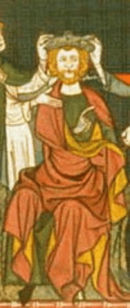Boso of Provence facts for kids
Quick facts for kids Boso |
|
|---|---|
 |
|
| King of Provence | |
| Reign | 879–887 |
| Predecessor | Louis the Stammerer |
| Successor | Louis the Blind |
| Born | c. 841 |
| Died | 11 January 887 |
| Spouse | Ermengard of Italy |
| Dynasty | Bivinids Bosonids (maternal) |
| Father | Bivin of Gorze |
| Mother | Richildis of Arles |
Boso (born around 841 – died January 11, 887) was a powerful Frankish nobleman. He belonged to the Bosonid family, which was connected to the famous Carolingian dynasty. Boso rose through the ranks to become the King of Lower Burgundy and Provence.
Who Was Boso's Family?
Boso was the son of Bivin of Gorze, who was a count in a region called Lotharingia. His mother was Richildis. Boso's aunt, Teutberga, was married to King Lothair II. He was also the nephew of another important person named Count Boso of Valois, after whom he was named.
How Boso Became Powerful
In 870, Boso's sister, Richilde, married King Charles the Bald of West Francia. This marriage was a big help for Boso's career. It allowed him to serve his new royal brother-in-law.
In the same year, Boso became the count of Lyon and Vienne. In 872, King Charles gave him even more important jobs. He became a chamberlain, which meant he managed the king's household. He also became master of porters for Charles's son, Louis the Stammerer. Boso also became the count of Bourges. Louis was a young king in Aquitaine, and Boso helped him manage that area.
In 875, Boso went with King Charles on a trip to Italy. There, Boso was made a duke and became a governor and count of Provence. He was like a special representative for the king. He also married Ermengarde, who was the only daughter of Emperor Louis II.
Boso didn't agree with King Charles's second trip to Italy in 877. He worked with other nobles who felt the same way. After King Charles died, these nobles made Charles's son agree to their rights and special powers.
Boso also became close with the Pope. He traveled with Pope John VIII in 878. The Pope even called Boso his "son."
Becoming a King
In April 879, King Louis the Stammerer died. He left behind two grown-up sons. Boso and other nobles wanted one of Louis's sons to be the only king. But in the end, both sons were chosen as kings.
Boso then decided he didn't want to follow the brothers. In July, he declared his independence. He used a special phrase, Dei gratia id quod sum, which means "by the Grace of God, that is what I am." He also said that his father-in-law, the Emperor, had named him as his heir.
On October 15, 879, bishops and nobles from the areas around the Rhône and Saône rivers met. They chose Boso as their king. This was a very important moment because Boso was not from the Carolingian royal family. It was the first time in over a hundred years that a king in Western Europe was chosen this way, based on a "free election."
Boso's new kingdom was often called the Kingdom of Provence. It included important church areas like Arles, Aix, Vienne, and Lyon.
After Louis and Carloman divided their father's kingdom, they joined forces with Charles the Fat to fight Boso. They took some of his northern lands. They also tried to capture Vienne, but they were not successful.
In 882, Boso was again attacked in Vienne by his own brother, Richard the Justiciar. Richard captured the city. After this, Boso lost much of his kingdom and was mostly limited to the area around Vienne.
Boso died in 887. His son, Louis the Blind, became king after him.
Boso's Family Life
Boso was married two times. We don't know the name of his first wife. His second wife was Ermengard of Italy, whom he married in March 876.
Boso and Ermengard had these children:
- Guilla of Provence (born December 873 – died before June 15, 929): She married Rudolph I of Burgundy and later Hugh of Italy.
- Engelberge (or Ethelberga): She married William I, Duke of Aquitaine.
- Louis the Blind (born before 884 – died June 5, 928): He became king after Boso.


